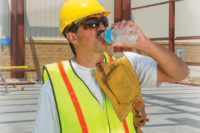Benefits
First, a written heat illness prevention plan can define and direct an employer’s safety and health efforts, and provide management and employees with safety and health goals and expectations, rules and standard procedures, and defined roles and responsibilities. It is the employer’s evidence of management concern for, and employee involvement with, safety and health for work in hot temperatures, which can be important if an OSHA inspection occurs.
Second, a written heat illness prevention plan can help an employer enforce its own safety rules in the workplace and avoid the possibility for confusion with the procedures that must be followed. Written rules about the precautionary measures that must be taken while working in the heat and why certain activities are prohibited provide consistency in how employees follow procedures and may avoid liability or fines.
Plan contents
The case for writing a heat illness prevention program is strong. However, once the determination is made to put the plan in writing, employers need to put pencil to paper. Similar to an investigative reporter, employers should seek to answer the 5W’s — who, what, when, where, why — and how, and begin documenting their findings.
Purpose
Begin a heat illness prevention written plan with a statement of purpose. Who is the plan designed to protect, what steps is the company committing to take, and how will the plan be executed.
Administration
Determine who will be involved in administering the heat illness prevention plan and what this person will be accountable for when establishing and implementing the plan. Think about the authority the company is willing to give this person, as well as his/her qualifications to conduct training and an evaluation of the risks.
Affected persons
Identify the departments that will be affected by the heat illness prevention plan and the specific persons/teams/departments that have responsibilities under the plan. Some possible positions include: maintenance workers, outdoor workers, factory workers, machine operators, molders, core setters, company nurse, first aid provider, safety manager, supervisors, administrative staff, and a variety of other positions.
Hazard assessment
Detail how the company will perform an environmental risk factor hazard assessment and how often the assessments will be performed. One way to assess heat hazards is to use the Wet Bulb Globe Thermometer. Another way is to use portable stress meters or monitors.
Based on OSHA’s Technical Manual, environmental heat measurements can be performed using a Wet Bulb Globe Thermometer method (WBGT), which essentially is a formula that calculates the Nature Wet-Bulb Temperature, Globe Temperature, and Dry-Bulb temperature and factors in heat from the sun, type of clothing worn, and workload. It is important to understand that metabolic energy required to perform a job task can impact the body’s ability to handle the heat in the environment.
These measurements should be made at, or as close as possible to, the specific work area where the worker is exposed. When a worker is not continuously exposed in a single hot area but moves between two or more areas having different levels of environmental heat, or when the environmental heat varies substantially at a single hot area, environmental heat exposures should be measured for each area and for each level of environmental heat to which employees are exposed.
There are also portable heat stress meters or monitors that can measure heat conditions. According to OSHA, these instruments can calculate both the indoor and outdoor WBGT index according to established American Conference of Governmental Industrial Hygienists’ Threshold Limit Value equations. With this information and information on the type of work being performed, heat stress meters can determine how long a person can safely work or remain in a particular hot environment.
Medical surveillance
Consider medical surveillance procedures for when there is a reasonable belief, based on objective evidence, that a particular employee is unable to perform an essential function or will pose a “direct threat” because of a medical condition. The scope and manner of any inquiries or medical examinations should be limited to information necessary to make the determination.
Control measures
Detail the control measures that will be implemented to reduce heat stress in a hot work environment.
Engineering controls
There are five major types of engineering controls employers can use to reduce heat stress:
- Ventilation
- Air
- Cooling
- Fans
- Shielding
- Insulation
Heat reduction can also be achieved by using power assists and tools that reduce the physical demands placed on a worker. However, for this approach to be successful, the metabolic effort required for the worker to use or operate these devices must be less than the effort required without them. Another method is to reduce the effort necessary to operate power assists.
Administrative controls
There are also administrative controls that can be used to reduce heat stress such as:
- Acclimating workers to the heat,
- Implementing worker monitoring programs,
- Reducing physical demands associated with the work,
- Providing recovery areas,
- Ensuring the appropriate amount of water is consumed,
- Using shifts to enable work during the cooler part of the day or night work, and
- Using intermittent rest periods with water breaks.
Personal protective equipment
Use of reflective clothing and auxiliary body cooling such as ice vests, wetted clothing, water-cooled garments, and circulating air in impermeable garments can also reduce the heat.
Emergency response
In cases of emergency, employers need to have procedures in place to ensure ready availability of medical personnel for consultation and treatment. Listing the procedures employees must follow along with phone numbers of primary emergency responders is important.
Training
Finally, there is training. Employees need to understand heat hazards; recognize the predisposing factors, danger signs, and symptoms; and be aware of first-aid procedures and their responsibilities. In the heat illness prevention program, detail the training program elements, who will perform the training, and how it will be delivered.
Final thought
Putting together a written plan for heat illness prevention may be an important step in protecting your employees this summer.


